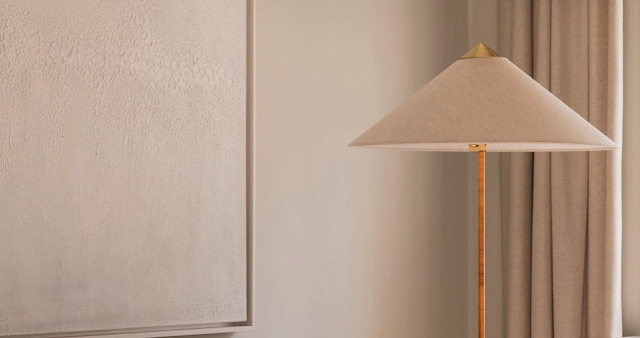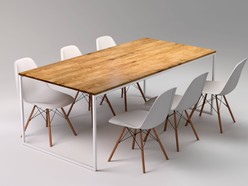Many people love a minimalist interior because of its practicality, functionality and natural materials. But some also think that this style is too cold and uncomfortable for home. In this article, you will learn about ways to help you make a minimalist interior cozy and relaxing.
Let's see how to get a simple, bright, clean and practical home with a “warm” interior.
1. Use warm colors
One of the biggest differences between classic and warm minimalism is the color palette. To follow the warm minimalist aesthetic, we should make the most of soft colors like cream taupe, warm white, and shades of beige as much as possible.
As you know, warm colors are located on the right side of the color wheel.
These are the colors that will help you achieve coziness and a feeling of warmth in the interior in a minimalist style. Stay away from cold shades, especially if you have a large room.
First, decide on the color of your walls. Use warm neutral tones, or if you want a bright and clean space, use white paint with a warm undertone.
It can be a great idea to choose a warm color as the main color and use its shades in detail to create a monochrome look in your interior. In classic minimalism, you can use black as an accent color to secure the composition.
2. Use natural materials
Another essential point to consider is texture. In warm minimalism, use as many natural materials as possible: wood, ceramics, stone, metal, leather, fabrics such as cotton, linen and stay away from plastic and artificial materials that can look unnatural and cold.
Don't forget that the minimalist style welcomes details such as raw or aged wood, ancient unusual ceramics, which add warmth and texture to the space. It is even better if these items are of craft value or are antique and unique.
3. Include items that have imperfections
The next tip is to include items that have imperfections in the interior. From the point of view of the “wabi-sabi” theory, a crumpled blanket, an old table covered with scratches, or a cracked porcelain vase, according to the Japanese, are much more valuable than new, even more expensive things — since it is imperfections that make each item unique.
We've talked about wabi-sabi in past articles, but if you don't know what that means, wabi-sabi is a Japanese concept that emphasizes the importance of finding beauty in imperfection. Instead of replacing all items with new ones, wabi-sabi focuses on finding beauty in all imperfect things, encouraging a sustainable approach to home decor.
The idea is to let objects age gracefully to appreciate the beauty that comes with time. In modern interiors, it is more important to combine them with new things. This perfect balance between old and new is what gives character to your warm, minimalist interior.
The next tip for creating a cozy look is imperfect furniture. This tip is key to the minimalist style because its concept shows that every piece of furniture is a piece of art and should also have a specific function.
Therefore, having the same furniture to fill the space is not a good idea. Pair the sofa with unique accent chairs and ottomans to break the symmetry and make the space more lively and cozy. A great way to combine furniture is to take shape into account. A wonderful option is to complement the straight lines of a minimalist sofa with a curved chair or an oval coffee table.
4. Straight and clean lines are essential
The next key element to consider in order to achieve a cozy minimalist effect is objects with interesting shapes. Straight and clean lines are essential, but in this style we need curly objects to create contrast and a softer aesthetic, which is why you can include streamlined shapes such as sofas, armchairs, tables, or decorative items such as flower pots, mirrors, and lamps.
Bringing nature into your home is a great way to add warmth and coziness to your interior. Therefore, indoor plants are a must to achieve the desired effect.
When choosing plants, think about decorative value: what suits your interior more — huge beautiful leaves or deep green color. It is better to have one or two amazing plants than a bunch of small ones that can visually oversaturate the space. Remember that less is more. Minimalism is fewer things, but better quality.
5. Use tall natural branches
Another way to bring nature into the space is to use tall natural branches. This is a great option if you don't have time to take care of your plants but want something natural in your home. This type of decor immediately adds interest and texture. You can use any branch you like, as long as you don't overdo it. Everything should look natural and casual.
6. Use only meaningful and functional items
Another way to give a minimalist space warmth and coziness is to use only meaningful and functional items in plain sight. Don't buy things to fill the space. You need to leave empty space to give your eyes a rest. Don't clutter empty surfaces with lots of knick-knacks, invest in unique items and artwork. Remember that less is more.
7. Use black metal objects
And the last tip — use black metal objects or warm-colored metal objects when decorating the interior. It can be gold, brass, bronze or matte black metal.
Use small decor items such as table lamps, floor lamps, sconces. They can add soft lighting and a warm mood. An excellent trick is to use neutral color temperature lighting (4000-4100 K) on the ceiling and use local lighting in the form of table and floor lamps of warm temperature (2700-3000 K) below. In this way, you can create a cozy atmosphere when you need it. would need.
- Start with a neutral and warm color palette;
- Add warm textures like wood, linen, cotton;
- Combine vintage with new, avoid ready-made furniture sets. Combine pieces of furniture of different shapes to break the symmetry;
- Do not forget to add nature to the interior, for example, tall plants or branches from your garden;
- Use meaningful and functional items. Don't buy things to fill the space. Remember that less is more.
- Choose metallic objects in a warm or neutral color, such as gold or black.





















